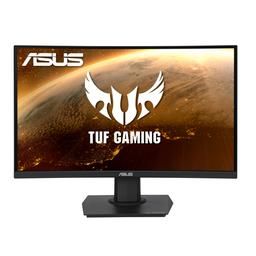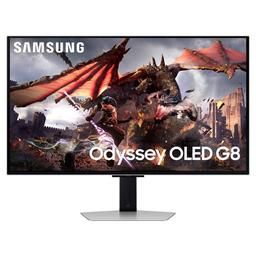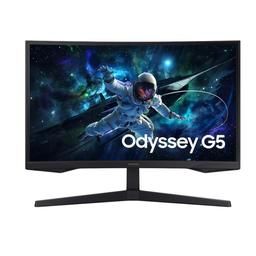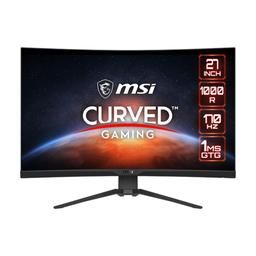The Best Gaming Monitors in 2025: Ultimate Buyer’s Guide for Competitive and Immersive Gamers
Franklin
Author
October 26, 2025
Published
10 min read
Estimated

Discover the best gaming monitors of 2025 with our complete guide. From ultra-fast 360 Hz panels for competitive FPS to immersive OLED and ultrawide displays for single-player adventures, we break down the top monitors by specs, use cases, and price. Learn how to choose the perfect monitor for your gaming style, whether you play on PC, console, or both.
Why Choosing the Right Gaming Monitor Matters in 2025
The monitor is the final frontier between your hardware and your senses. No matter how powerful your GPU or how optimized your system is, the screen dictates what you actually see and feel while gaming. In 2025, gaming monitors have evolved well beyond the simple metrics of resolution and size — they now integrate technologies like OLED, mini-LED, 360 Hz refresh rates, variable refresh sync (VRR), and HDR implementations that dramatically affect both performance and immersion.
For competitive gamers, the difference between a 165 Hz panel and a 360 Hz one can mean the difference between reacting first or losing a duel. Milliseconds matter. Technologies like NVIDIA Reflex Analyzer, AMD FreeSync Premium Pro, and low-latency backlight strobing are now critical tools for esports players chasing every edge in titles like Valorant, CS2, or Fortnite.
For single-player enthusiasts, the priorities shift. Here, contrast ratio, color accuracy, pixel response, and HDR fidelity define the experience. A deep-black OLED or a quantum-dot enhanced VA panel brings cinematic visuals to story-driven games such as Cyberpunk 2077 or Horizon Forbidden West, turning each frame into an art piece. Ultrawide monitors, once a niche choice, are now common for open-world games and simulators, delivering unmatched immersion.
At the same time, console and PC gaming are converging. With both PS5 and Xbox Series X supporting 120 Hz refresh, HDMI 2.1, and VRR, modern monitors are expected to handle both PC and console duties seamlessly. As a result, buyers in 2025 face a much more complex landscape — but also more freedom than ever.
That’s where MonitorPicker and this guide come in. Using insights from monitor-picker.com
What Makes a Gaming Monitor Great (Core Metrics Explained)
Before diving into specific models, it’s essential to understand what actually defines a great gaming monitor. While marketing often emphasizes refresh rate or resolution, the real performance depends on how all these factors interact — from panel technology to latency optimization. Below, we’ll break down the most important aspects to consider when evaluating a display for gaming in 2025.
Refresh Rate and Motion Clarity
The refresh rate, measured in hertz (Hz), defines how many times per second your display updates the image. A 60 Hz monitor refreshes the image 60 times per second, while a 360 Hz display does so six times faster. Higher refresh rates reduce motion blur and provide smoother, more responsive gameplay.
- 144 Hz is now the minimum standard for gaming monitors, suitable for most titles and casual competitive play.
- 240 Hz monitors provide a noticeable improvement in motion smoothness and responsiveness, ideal for fast-paced shooters and esports.
- 360 Hz and above are designed for elite-level competitive gamers who want absolute minimal latency.
It’s important to note that refresh rate only helps if your GPU can consistently output frames near or above that rate. For example, a 360 Hz monitor paired with a mid-range GPU that delivers 120 FPS won’t reach its potential.
Response Time and Input Lag
Response time measures how quickly a pixel can change from one color to another, often expressed as gray-to-gray (GtG) time. A lower response time reduces ghosting and motion artifacts.
- 1 ms GtG is the standard target for competitive gaming.
- OLED panels can achieve sub-millisecond response times, offering nearly instantaneous transitions.
- However, some manufacturers use overly aggressive overdrive to reach “1 ms,” which can cause inverse ghosting — visible halos behind moving objects.
Input lag, while related, refers to the delay between your input (mouse, keyboard, controller) and the visual response on the screen. The best gaming monitors maintain input lag under 5 milliseconds, ensuring near-instantaneous feedback.
Panel Technology: IPS, VA, TN, and OLED
Panel type directly influences image quality, viewing angles, and speed. Each technology has trade-offs:
- IPS (In-Plane Switching): Excellent color accuracy and viewing angles. Modern fast IPS panels (e.g., LG Nano IPS) have nearly caught up with TN in response time, making them ideal for balanced performance across genres.
- VA (Vertical Alignment): Superior contrast ratios (up to 3000:1 or higher), making them great for dark-room gaming and cinematic visuals. However, VA panels may show minor ghosting in dark scenes.
- TN (Twisted Nematic): Once dominant in esports due to ultra-fast response times, TN panels now feel outdated in color and contrast, though models like the BenQ Zowie XL2566K still perform excellently in competitive environments.
- OLED (Organic Light-Emitting Diode): The current pinnacle of image quality. OLED monitors offer true blacks, perfect contrast, and near-instant pixel response. They are outstanding for both competitive and cinematic gaming, though they can be prone to image retention over long periods.
Ergonomics, Connectivity, and Build Quality
A good gaming monitor should also feel comfortable to use. Adjustable stands (height, tilt, swivel, pivot) are crucial for long sessions. Modern connectivity standards to look for include:
- DisplayPort 1.4 or 2.1 for PC gaming
- HDMI 2.1 for consoles
- USB-C with 90W Power Delivery for laptop setups
- Headphone jack and built-in KVM switch for multi-device workflows
Build quality also matters. Thin bezels, solid stands, and efficient cooling designs contribute to the monitor’s longevity and usability.
Best Gaming Monitors of 2025 (Model Reviews and Recommendations)
Below are several standout gaming monitors for 2025, each targeting a different use case, price point, or technical niche. For each model, I include key specs, strengths & trade-offs, and ideal usage scenarios (FPS, single-player, console, ultrawide, etc.).
ASUS ROG Strix OLED XG27AQDMG
Key Specs
- Resolution: 2560 × 1440 (QHD)
- Refresh Rate: 240 Hz
- Panel: OLED
- Response Time: sub-ms
- HDR: Full support (Dolby Vision, HDR10)
- Connectivity: DisplayPort, HDMI, USB, KVM switch
This is one of the most balanced OLED gaming monitors on the market for 2025. It offers the deep blacks and instantaneous pixel transitions of OLED without pushing into extreme ultrawide or 4K. It handles motion extremely cleanly, with negligible ghosting or blur. Its refresh rate is high enough for competitive play while keeping GPU demands more manageable than full 4K/240 Hz. Online reviews consistently rate it among the top OLED picks for visual fidelity and responsiveness.
However, OLED panels can be more expensive, and long static HUDs (scoreboards or UI) carry a greater risk of burn-in over very long use (though modern OLEDs mitigate this). Also, to fully leverage the monitor, your GPU must push high frame rates in 1440p.
Best Modes / Use Cases
- Single-player / Cinematic: Excellent. Perfect blacks and HDR make story games shine.
- Competitive FPS / Esports: Very viable—240 Hz is high enough for most players.
- Hybrid / Console + PC: Good match if your console and PC support HDMI 2.1 / VRR.
Samsung Odyssey OLED G8

Key Specs
- Resolution: 3840 × 2160 (4K)
- Refresh Rate: 240 Hz
- Panel: OLED (QD-OLED)
- Response Time: 0.03 ms
- HDR: High peak brightness
- Connectivity: DisplayPort 2.1, HDMI 2.1, etc.
Strengths & Trade-offs
This is Samsung’s premium OLED flagship—one of the rare 4K/240 Hz gaming monitors. Thanks to DisplayPort 2.1 support, it's targeted at high-end GPU users who want crisp visuals and ultra-smooth performance. It excels in both high-fidelity and high-speed contexts. Review coverage from sites like RTINGS identifies 4K OLEDs as the top-tier displays to beat.
Trade-offs: To use 240 Hz at 4K demands a very powerful GPU (e.g. RTX 4080/4090 class). Also, brightness in HDR may be constrained relative to mini-LED alternatives, and OLED long-term usage must be managed carefully.
Best Modes / Use Cases
- Single-player / immersion: One of the best possible displays for story and cinematic games.
- High-end PC only: Best for users with GPUs that can push 200+ FPS in 4K.
- Console + PC hybrid: Ideal if you want 4K visuals on both platforms with adaptive sync support.
Samsung Odyssey G5

Key Specs
- Resolution: 2560 × 1440 (or variants)
- Refresh Rate: typically up to 165 Hz or 240 Hz
- Panel: Curved VA
- Response Time: ~1 ms
- HDR: modest
Strengths & Trade-offs
This is a reliable midrange curved monitor. It’s not cutting-edge, but its balance of price and specs makes it widely used. The curved VA gives immersive contrast, particularly for darker scenes.
The downsides: VA motion clarity can lag behind IPS or OLED in high-speed scenes. HDR is limited.
Best Modes / Use Cases
- Single-player / cinematic: Good value for immersion on a budget
- Everyday / casual FPS: Decent, though serious esports players might prefer faster panels
- Budget-conscious hybrid setup: Suitable for users needing both PC and console support without going OLED.
MSI MAG 275CQRFDE QD

Key Specs
- Resolution: 2560 × 1440
- Refresh Rate: up to 165 Hz
- Panel: QD-IPS (Quantum Dot IPS)
- Response Time: ~1 ms
- HDR: moderate
Strengths & Trade-offs
Quantum Dot IPS panels hit a sweet spot: good color, decent contrast, and faster response than traditional IPS. This model is especially relevant for players who want bright, vivid visuals and strong color fidelity without paying OLED premiums.
The trade-off is contrast in dark scenes may not match VA or OLED, and HDR brightness is less ambitious.
Best Modes / Use Cases
- Single-player / immersive / artistic: Great for those who care about color accuracy and bright displays.
- Competitive FPS / esports: Solid option for mid-tier speed demands.
- Content creators + gamers: Good for those who also want color accuracy for creative tasks.
ASUS TUF Gaming VG24VQER

Key Specs
- Resolution: Full HD (1920 × 1080)
- Refresh Rate: ~165 Hz
- Panel: Curved VA or advanced variant
- Response Time: 1 ms
- HDR: minimal or none
Strengths & Trade-offs
This is a solid budget/entry-level gaming monitor, especially for competitive FPS where lower resolution means higher frame rates. It’s often used for setups where performance is prioritized over visual fidelity.
The trade-offs are evident: you lose sharpness and HDR quality vs higher-resolution displays, and large-screen real estate is limited.
Best Modes / Use Cases
- Competitive FPS / esports: Ideal for players prioritizing frame rate over detail.
- Budget builds / eSports starters: Great as the first “real” gaming monitor.
- Non-graphically intensive genres: MMORPGs, MOBAs, etc. don’t demand max detail, so this works well.
Real-World Suitability by Genre
- FPS / Esports: High refresh (240–360 Hz), low input lag. Small size (24–25") preferred for fast eye tracking.
- Single-player / RPG / Story Games: OLED or VA panels, HDR support, immersive contrast. 27–32" recommended.
- Racing / Flight / Simulation: Ultrawide or 32:9 curved monitors maximize field of view. GPU must handle high frame rates at larger resolutions.
- MMO / Strategy / MOBA: Large screens with decent refresh and color accuracy. High resolution helps manage UI elements.
Common Pitfalls & Buying Tips
- Overhype of Specs: 360 Hz is only useful if GPU can deliver high FPS.
- OLED Burn-in: Avoid static UI for long sessions.
- Panel Type Trade-offs: IPS = color, VA = contrast, TN = speed. Choose according to genre.
- Connectivity: Ensure HDMI 2.1 for consoles, DisplayPort 1.4+ for PC.
- Ergonomics: Height/tilt/swivel adjustability is crucial for long gaming sessions.
Conclusion & Buying Checklist
Buying Checklist
- Define your primary gaming type (FPS, RPG, Simulation).
- Set a budget and check GPU capability vs monitor refresh/resolution.
- Pick panel type: IPS, VA, TN, or OLED according to your priorities.
- Verify connectivity: HDMI 2.1 / DisplayPort 1.4+, VRR support.
- Consider ergonomics and desk space.
- Look for reliable HDR, color gamut, and response time specs.
Final Thoughts:
Choosing the right gaming monitor in 2025 is about balancing speed, fidelity, and immersion. Whether you’re chasing milliseconds in competitive FPS, exploring cinematic worlds in RPGs, or dominating open-world racing, the right display will elevate your gaming experience. Use this guide to match monitors to your style and budget, ensuring your next upgrade truly enhances your play.